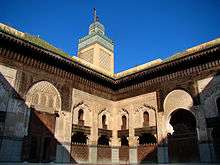Andalusian Mosque
Coordinates: 34°02′05″N 4°34′50″E / 34.0347°N 4.5805°E

Andalusian Mosque (Arabic: مسجد الأندلسيين, translit. Masjid al-Andalusiyyin) is a mosque in Fes el Bali, the old medina quarter of the city of Fez, Morocco. The mosque dates back to the inception of the city in the 9th century, with the completion of the initial foundation in 859-860. This makes it one of the oldest mosques in the world. The mosque had been renovated and expanded several times since then. Today, it is one of the relatively few remaining Idrisid-era establishments and the main landmarks of the city.
Description
The mosque was established in 859-860 by the Andalusian refugees from the city of Cordoba, under the sponsorship of Maryam bint Mohammed bin Abdullah. In 818, around hundreds of families fled Cordoba from the successive repressions after their rebellion against the Umayyads. They settled in the eastern bank of the River of Fez which used to be the settlement known as Al-'Aliya. The refugees began building the large Jami Masjid in the area soon after the migration. The original construction was modest; according to the 12th-century Andalusian geographer Al-Bakri, the mosque consisted of seven vaults and a small sahn where a walnut tree and several other trees were planted. The mosque had access to abundant water through a channel known as Wadi Masmouda.[1][2]
In the 10th century, the Umayyads of Cordoba erected the minaret which survives up until today. The minaret is square-shaped and has simple decorations on its frame. It is built to resemble the minaret of the Mosque of Al-Quaraouiyine. During the rule of Obaidullah, a governor of Fez during the Fatimid-era, the mosque became the place for khutbah (religious sermon) during the Friday Prayer, replacing the position of the Mosque of Al-Ashyakh which was the first mosque built in the western settlement. Muhammad al-Nasir, the fourth Almohad caliph, ordered the construction of the gate during 1203-1207 which overlooks the northern facade. The gate is topped by two domes, one of which is built of carved plasters and another is built of cedar wood, and decorated by the combination of wooden zellige and qashani works. It was restored during the Alaouite period. Several historians, artists, and scholars, including the orientalist Georges Marçais praised the architecture as a masterpiece of Moroccan architectural style. The caliph built as well a water tank, a fountain which resembles that of the Mosque of Al Quaraouiyine on the northern facade of the building, and an apartment made of stones for imams of the mosque on the second floor above the prayer hall for women. During the Marinid period, several parts of the building including the ceiling, beams, and fountain were restored. The mosque also contains seven courses for education, as well as two libraries, similarly to the Mosque of Al Quaraouiyine, which considered makes it the second most important mosque in the medina of Fez.[1][2]
Gallery
References
- 1 2 مسجد الأندلسيين. Museum with no Frontiers. Retrieved January 23, 2018.
- 1 2 Jami' al-Andalusiyyin. Archnet. Retrieved January 23, 2018.


